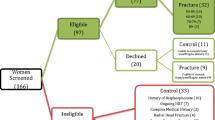Abstract
Background: To investigate the impact on bone and muscle of pathological conditions involving only one of the upper limbs, it is important to know the physiological differences due to the dominance effect. Aim: To evaluate any physiological differences between dominant and non-dominant upper limbs in terms of bone mineral density (BMD), muscle mass, and muscle density at different levels. Subjects and methods: The study considered 60 right-handed healthy adults, 30 men and 30 women. Cortical BMD, muscle area, and muscle density were investigated by pQCT-XCT-3000 Stratec at the proximal radius, trabecular and total BMD at the distal radius, and trabecular and cortical BMD at the second phalanx of the third finger. Hand grip strength was also measured. Results: No significant differences in BMD were found between the dominant and non-dominant upper limbs at any of the sites considered, in men or women. Muscle density was also similar on the two sides, whereas muscle area at the proximal radius was significantly lower on the non-dominant side in both men [4177.5±475.1 vs 4009.3±552.7 mm2; Δ%: 4.1%; 95% confidence interval (CI) 1.7%–6.5%] and women (2903.9±470.9 vs 2720.3±411.7 mm2; Δ%: 6.1%; 95%CI 4.3%–7.9%). Hand grip strength proved greater on the right side in both men (48.5±8.8 vs 45.2±8.7 kg; Δ% 7.1; p<0.001) and women (29.1±4.3 vs 27.0±5.1 kg; Δ% 7.1; p<0.001). Conclusion: The dominance effect does not seem to influence trabecular or cortical BMD at any of the sites in the upper limb. Muscle density is not modified by dominance, while muscle area is reduced on the non-dominant side and this should be borne in mind when the effect of pathological conditions on the body composition of a single forearm is investigated.
Similar content being viewed by others
References
Ferretti JL, Capozza RF, Cointry GR, Capiglioni R, Roldan EJ, Zanchetta JR. Densitometric and tomographic analyses of musculoskeletal interactions in humans. J Musculoskelet Neuronal Interact 2000, 1: 31–4.
Tsuji S, Tsunoda N, Yata H, Katsukawa F, Onishi S, Yamazaki H. Relation between grip strength and radial bone mineral density in young athletes. Arch Phys Med Rehabil 1995, 76: 234–8.
Walters J, Koo WW, Bush A, Hammami M. Effect of hand dominance on bone mass measurement in sedentary individuals. J Clin Densitom 1998, 1: 359–67.
Deodhar AA, Brabyn J, Jones PW, Davis MJ, Woolf AD. Measurement of hand bone mineral content by dual energy x-ray adsorptiometry: development of the method, and its application in volunteers and in patients with rheumatoid arthritis. Ann Rheum Dis 1994, 53: 685–90.
Hatipoglu HG, Selvi A, Ciliz D, Yuksel E. Quantitative and diffusion MR imaging as a new method to assess osteoporosis. Am J Neuroradiol 2007, 28: 1934–7.
Grampp S, Nather A, Rintelen B, et al. Peripheral quantitative CT of the forearm: scanner cross-calibration using patient data. Br J Radiol 2000, 73: 275–7.
Guglielmi G, De Serio A, Fusilli S, et al. Age-related changes assessed by peripheral QCT in healthy Italian women. Eur Radiol 2000, 10: 609–14.
Tysarczyk-Niemeyer G. New noninvasive pQCT devices to determine bone structure. J Jpn Soc Bone Morphom 1997, 7: 97–105.
Neu CM, Manz F, Rauch F, Merkel A, Schoenau E. Bone densities and bone size at the distal radius in healthy children and adolescents: a study using peripheral quantitative computed tomography. Bone 2001, 28: 227–32.
Di Leo C, Tarolo GL, Bestetti A, et al. Valutazione delle proprietà geometriche, biomeccaniche e osteodensitometriche del radio ultradistale mediante Tac periferica. Radiol Med 1999, 97: 229–35.
Louis O, Soykens S, Willnecker J, Van Den Winkel, Osteaux M. Cortical and total bone mineral content of the radius: accuracy of peripheral computed tomography. Bone 1996, 18: 467–72.
Augat P, Gordon CL, Lang TF, Iida H, Genant HK. Accuracy of cortical and trabecular bone measurements with peripheral quantitative computed tomography (pQCT). Phys Med Biol 1998, 43: 2873–83.
Haapasalo H, Kontulainen S, Sievänen H, Kannus P, Järvinen M, Vuori I. Exercise-induced bone gain is due to enlargement in bone size without a change in volumetric bone density: a peripheral quantitative computed tomography study of the upper arms of male tennis players. Bone 2000, 27: 351–7.
Heinonen A, Sievänen H, Kannus P, Oja P, Vuori I. Site-specific skeletal response to long-term weight training seems to be attributable to principal loading modality: a pQCT study of female weightlifters. Calcif Tissue Int 2002, 70: 469–74.
Ashizawa N, Nonaka K, Michikami S, et al. Tomographical description of tennis-loaded radius: reciprocal relation between bone size and volumetric BMD. J Appl Physiol 1999, 86: 1347–51.
Schneider P, Reiners C. Peripheral quantitative computed tomography. In: Genant HK, Guglielmini G, Jergas M, editors. Bone Densitometry and Osteoporosis. Berlin: Springer Verlag 1998, 349–63.
Kunelius A, Darzins S, Cromie J, Oakman J. Development of normative data for hand strength and anthropometric dimensions in a population of automotive workers. Work 2007, 28: 267–78.
Incel NA, Ceceli E, Durukan PB, Erdem HR. Grip strength: effect of hand dominance. Singapore Med J 2002, 43: 234–7.
Armstrong CA, Oldham JA. A comparison of dominant and nondominant hand strengths. J Hand Surg [Br] 1999, 4: 421–5.
Cesari M, Leeuwenburgh C, Lauretani F, et al. Frailty syndrome and skeletal muscle: results from the Invecchiare in Chianti study. Am J Clin Nutr 2006, 83: 1142–8.
Wren TA, Bluml S, Tseng-Ong L, Gilsanz V. Three-point technique of fat quantification of muscle tissue as a marker of disease progression in Duchenne muscular dystrophy: preliminary study. AJR Am J Roentgenol 2008, 190: W8–12.
Mazzali G, Di Francesco V, Zoico E, et al. Interrelations between fat distribution, muscle lipid content, adipocytokines, and insulin resistance: effect of moderate weight loss in older women. Am J Clin Nutr 2006, 84: 1193–9.
Author information
Authors and Affiliations
Corresponding author
Rights and permissions
About this article
Cite this article
Sergi, G., Perissinotto, E., Zucchetto, M. et al. Upper limb bone mineral density and body composition measured by peripheral quantitative computed tomography in right-handed adults: The role of the dominance effect. J Endocrinol Invest 32, 298–302 (2009). https://doi.org/10.1007/BF03345715
Accepted:
Published:
Issue Date:
DOI: https://doi.org/10.1007/BF03345715




